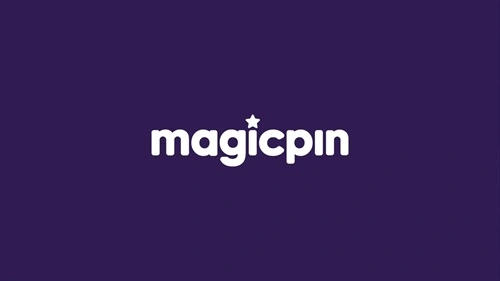Magicpin, founded in 2015 by Anshoo Sharma and Brij Bhushan, is a hyperlocal discovery and rewards platform that connects users with offline merchants. It operates as a bridge between customers and local businesses, offering cashback, discounts, and rewards to users while driving footfall and sales for merchants. Over the years, Magicpin has become a prominent player in India’s hyperlocal commerce ecosystem, covering diverse categories like food, fashion, beauty, grocery, and more. This article delves into Magicpin’s business model and explores how it earns money.
Overview of Magicpin’s Business Model

Magicpin operates on a hyperlocal discovery and cashback-based business model. It leverages user-generated content (photos, reviews, and ratings) and rewards users for visiting and shopping at local stores. Its ecosystem revolves around three key stakeholders:
- Consumers: Individuals who use the app to discover stores, restaurants, and services nearby and earn rewards for their transactions.
- Merchants: Local businesses such as restaurants, fashion stores, grocery shops, and salons that partner with Magicpin to boost visibility and attract customers.
- Brands: National and regional brands that use Magicpin’s platform to promote their products and drive in-store purchases.
The platform incentivizes offline spending by combining digital engagement with physical transactions, creating a win-win for consumers and businesses.
Revenue Streams
Magicpin generates revenue through multiple channels:
a) Merchant Subscription Fees
Magicpin partners with local merchants who pay subscription fees to access the platform’s services. These include:
- Increased Visibility: Merchants gain exposure to Magicpin’s large user base through listings, promotions, and location-based discovery.
- Customer Acquisition: By offering cashback and discounts, merchants attract new customers and encourage repeat visits.
Merchants can choose from different subscription tiers, with higher tiers offering advanced features like premium placement, analytics, and targeted marketing.
b) Commission on Transactions
Magicpin earns a percentage-based commission on every transaction made by users at partner outlets. This fee is typically a small cut of the total bill value and is charged to the merchant for driving traffic and facilitating the sale.
c) Advertising and Sponsored Listings
Magicpin allows businesses and brands to promote their offerings through:
- Sponsored Listings: Merchants and brands pay to appear at the top of search results within the app, gaining higher visibility.
- Targeted Ads: Businesses can run geo-targeted and category-specific advertising campaigns to reach their desired audience.
d) Affiliate Marketing and Brand Partnerships
Magicpin collaborates with national and regional brands to promote their products at local stores. Brands pay Magicpin for:
- Product Campaigns: Driving in-store purchases of specific products.
- Data Insights: Leveraging Magicpin’s transaction data to understand consumer behavior and optimize campaigns.
e) User Verification and Rewards
Magicpin’s cashback and reward system is a major draw for users. The company partners with merchants and brands to offer rewards, such as:
- Cashback in the form of Magicpin Points (MagicPoints) redeemable for future purchases.
- Vouchers and offers sponsored by brands.
Merchants and brands pay Magicpin to fund these rewards as part of their customer acquisition and retention strategies.
f) Premium Membership Plans
Magicpin offers premium membership plans to users, which provide benefits like higher cashback rates, exclusive discounts, and additional rewards. The subscription fees from these plans contribute to Magicpin’s revenue.
g) Data Monetization
Magicpin generates valuable insights from its user base, such as purchase patterns, spending behavior, and footfall trends. While user data is anonymized, it is monetized by:
- Selling aggregated data insights to brands for marketing and strategy optimization.
- Helping merchants track campaign performance and customer preferences.
Key Cost Drivers
Operating a hyperlocal platform like Magicpin involves several cost components:
a) Technology and Development
Magicpin invests heavily in its app, algorithms, and analytics tools to ensure a seamless user experience and deliver value to merchants.
b) Rewards and Cashback
The platform’s reward system is a significant cost. Magicpin funds part of the cashback incentives to attract and retain users.
c) Marketing and Customer Acquisition
Magicpin allocates a substantial budget to digital marketing, social media promotions, and referral programs to grow its user base.
d) Merchant Support and Sales
Maintaining partnerships with thousands of merchants requires a robust sales and support team to onboard new businesses and manage existing relationships.
e) Operational Costs
Costs associated with running the business, including office spaces, employee salaries, and general administrative expenses, contribute to the overall cost structure.
Unique Features Driving Revenue Growth
Magicpin’s success can be attributed to several strategies and features:
a) User-Generated Content (UGC)
Magicpin encourages users to upload photos and reviews of their experiences at partner outlets. This creates authentic, location-specific content that enhances trust and engagement.
b) Hyperlocal Targeting
The platform leverages location-based services to connect users with nearby businesses, ensuring relevance and convenience for consumers and increased footfall for merchants.
c) Gamified Rewards
Magicpin’s reward system, where users earn points for transactions and content uploads, gamifies the shopping experience, driving higher engagement and loyalty.
d) Focus on Tier 2 and Tier 3 Cities
By expanding beyond metropolitan areas, Magicpin taps into the growing demand for digital platforms in smaller cities and towns, where offline retail still dominates.
e) Partnerships with Brands
Collaborations with major brands allow Magicpin to offer exclusive deals and discounts, enhancing its appeal to users while generating additional revenue.
Challenges and Opportunities
Challenges
- Intense Competition: Magicpin competes with platforms like Paytm, Swiggy, Zomato, and Dunzo in the hyperlocal space.
- Scalability of Offline Partnerships: Managing relationships with a vast network of merchants across diverse geographies can be challenging.
- Cashback Burn: Funding rewards to attract users can strain profitability in the short term.
Opportunities
- Growing Offline Market: India’s offline retail market, particularly in Tier 2 and Tier 3 cities, presents immense growth potential.
- Data Monetization: Expanding data-driven insights for brands and merchants can open new revenue streams.
- E-commerce Integration: Collaborating with online platforms to create hybrid offline-online experiences can drive further engagement.
Financial Performance
Magicpin has shown consistent growth in user base and transactions. The platform’s unique combination of cashback incentives, hyperlocal targeting, and data monetization has attracted significant funding from investors, including Lightspeed Venture Partners. The company continues to focus on expanding its footprint and achieving profitability through operational efficiencies and new revenue streams.
Conclusion
Magicpin’s innovative business model effectively combines digital engagement with offline commerce, making it a valuable platform for users, merchants, and brands alike. By incentivizing offline spending through rewards and creating hyperlocal discovery opportunities, Magicpin has positioned itself as a leader in India’s hyperlocal commerce market. With its focus on data-driven insights, partnerships, and Tier 2 and Tier 3 expansion, Magicpin is well-poised for sustained growth in the dynamic retail ecosystem.

